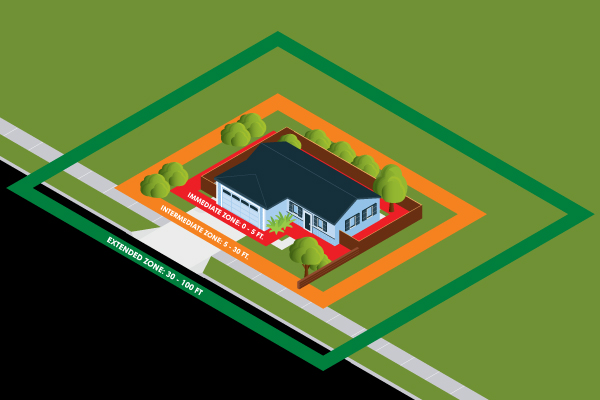A defensible home has the greatest potential for survivability in the event of a wildfire during average wind conditions. Defensible homes are those that are in compliance with "defensible space" requirements or a fuel modification program and have been "hardened" in accordance with Chapter 7A of the California Building Code.
Defensible Space
Defensible space is the required distance between a structure and the wildland area that, under normal conditions, creates a sufficient buffer to slow or halt the spread of wildfire to a structure. It protects the home from igniting due to direct flame impingement and radiant heat. Compliance is essential for structure survivability during wildfire conditions. Defensible space requirements apply to all structures regardless of the year built.
ZONE 0
Extends 0 - 5 feet out from the buildings, structures, decks, etc.
- Avoid anything combustible in this zone: woody plants, mulch, woodpiles, combustible trellises, and stored items.
- This is an excellent location for walkways, hardscaping with pavers, rock mulch, or pea gravel.
- Zone 0 should be coupled with a 6" vertical noncombustible section at the intersection between the ground and the exterior siding.
ZONE 1
Extends 5 - 30 feet out from buildings, structures, decks, etc.
- Remove all dead or dying vegetation.
- Trim tree canopies regularly to keep their branches a minimum of 10 feet from structures and other trees.
- Remove leaf litter (dry leaves and pine needles) from yard, roof, and rain gutters.
- Relocate woodpiles or other combustible materials into Zone 2.
- Remove combustible material and vegetation from around and under decks.
- Remove or prune vegetation near windows.
- Remove “ladder fuels” (low-level vegetation that allows the fire to spread from the ground to the tree canopy). Create a separation between low-level vegetation and tree branches. This can be done by reducing the height of low-level vegetation keep plants and shrubs below 18 inches in height and/or trimming low tree branches.
ZONE 2
Extends 30-100 feet out from buildings, structures, and decks.
Reduce the continuity of fuels by removing dead material and removing and/or thinning vegetation. Minimum spacing between vegetation is 3 times the dimension of the plant.
- Remove “ladder fuels.”
- Cut or mow annual grass down to a maximum height of 4 inches.
- Trim tree canopies regularly to keep their branches a minimum of 10 feet from other trees.


